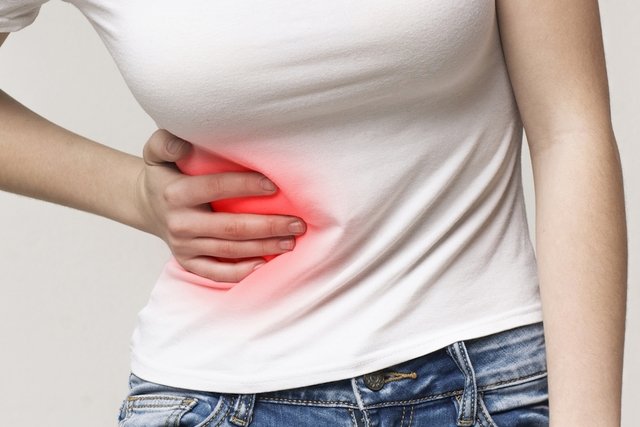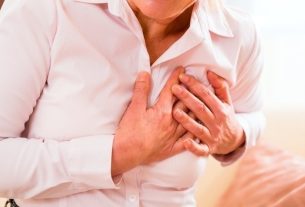Gallstones are a relatively common problem, being more common in people who eat a diet very rich in fats and simple carbohydrates, or who have high cholesterol, for example.
The most common symptoms of this type of change include severe pain on the right side of the belly, fever above 38ºC, yellowish color in the eyes, diarrhea and nausea. Although they are related to the gallbladder, this does not mean that, whenever they appear, they indicate the presence of gallstones, as they can also be linked to other gastric or intestinal problems.
However, gallstones are considered a medical emergency that should be treated as quickly as possible. Therefore, the important thing is to always pay attention to your own body and identify how symptoms evolve to know when they could really indicate a serious situation. If the pain is very severe or if more than 2 of the common symptoms of gallstones appear, it is always advisable to consult a doctor or go to the hospital to confirm the diagnosis and begin appropriate treatment.

Below, we list the most common symptoms of this problem and why they may not always indicate gallstones:
1. Severe pain on the right side of the abdomen
Any type of severe pain should always be evaluated by a doctor and, therefore, it is always important to go to the hospital. However, pain in the upper right side of the abdomen is not just a sign of gallstones, it can occur in the presence of problems in other organs, especially the liver.
Since the liver and gallbladder work together, it is normal for the symptoms of changes in any of these organs to be similar and, therefore, the only way to be sure what it is is to go to the hospital or consult a doctor. a hepatologist to carry out tests such as abdominal ultrasound or MRI, to confirm the diagnosis and initiate the most appropriate treatment.
The problems that most frequently cause pain on the right side of the abdomen are hepatitis and cirrhosis, but it can also be a sign related to heart failure, for example. See the main causes of abdominal pain.
2. Fever above 38º C
Fever is a very general symptom, as it is the body’s way of naturally dealing with various types of problems and infections. Therefore, in the case of a fever, the most important thing is to assess what other symptoms appear and whether the fever is very high, that is, whether it is higher than 39ºC.
Other gastrointestinal problems that can cause fever and look like gallstones include Crohn’s disease or appendicitis, but in these situations it is common for pain to appear in the lower abdomen, and in appendicitis this pain is usually more localized. on the right side, just above the hip.
3. Yellowish color in the eyes and skin
The yellow color in the eyes and skin is a medical condition known as jaundice and occurs due to the accumulation of bilirubin in the blood. Under normal conditions, this substance is produced by the liver and stored in the gallbladder, then released with bile into the intestine and eliminated in the feces. However, when it is produced in excess or when it cannot be eliminated properly, it ends up accumulating in the blood, giving rise to a yellowish color.
Therefore, any problem that can affect the production or storage of bile can cause this type of symptom. Therefore, although the yellowish color is always assessed by the doctor as possibly indicating a problem with the gallbladder, it is also assessed whether there is any change in the liver, as these are mainly responsible for its production and storage.
Check out the main causes of yellow skin.

4. Persistent diarrhea
Diarrhea occurs in cases of gallstones because the bile, which is used to digest fat, cannot leave the gallbladder and reach the intestine, causing there to be excess fat in the feces which, in addition to making them more soft, it also increases the intensity of bowel movements. However, diarrhea is also a symptom that can occur in association with other gastric or intestinal problems, such as gastroenteritis, Crohn’s disease and food intolerances.
These problems are quite different and require different treatments, but their symptoms can be very similar, including abdominal pain, fever and even nausea and vomiting. For this reason, if diarrhea persists for more than 1 week, you should consult a gastroenterologist to understand the cause and begin the most appropriate treatment.
See what can cause persistent diarrhea and what to do.
5. Nausea and vomiting
Another common symptom in cases of gallstones is the appearance of constant nausea and vomiting, but these are also signs that can appear with other gastrointestinal problems, mainly gastritis, Crohn’s disease, appendicitis and any liver problem.
Therefore, nausea and vomiting should always be evaluated by a doctor, especially if they last for more than 24 hours. Understand better what causes can cause nausea and vomiting.
6. Loss of appetite
Loss of appetite, although it may seem like a more specific symptom of gallstones, can also happen when there is some gastric, intestinal or liver change. However, lack of appetite can also appear in milder situations, such as colds or flu.
Therefore, whenever it appears and lasts more than 3 days, or is accompanied by any of the symptoms indicated here, it is important to go to the hospital or consult a gastroenterologist or hepatologist. Check out what can cause a lack of appetite and what to do in each case.
When to suspect gallstones
Although these symptoms can indicate several other problems, they are still important in identifying a case of gallstones. Therefore, there is a greater risk of having a gallstone when:
- The pain appears suddenly and is very intense, in the upper right region of the abdomen;
- More than 2 of the associated symptoms appear;
- Symptoms appear or worsen after meals.
In these cases, you should go to the hospital or consult a gastroenterologist, or hepatologist, to carry out the necessary tests, confirm the diagnosis and start the most appropriate treatment.

Sign up for our newsletter and stay up to date with exclusive news
that can transform your routine!
Warning: Undefined array key "title" in /home/storelat/public_html/wp-content/plugins/link-whisper-premium/templates/frontend/related-posts.php on line 12
Warning: Undefined array key "title_tag" in /home/storelat/public_html/wp-content/plugins/link-whisper-premium/templates/frontend/related-posts.php on line 13



